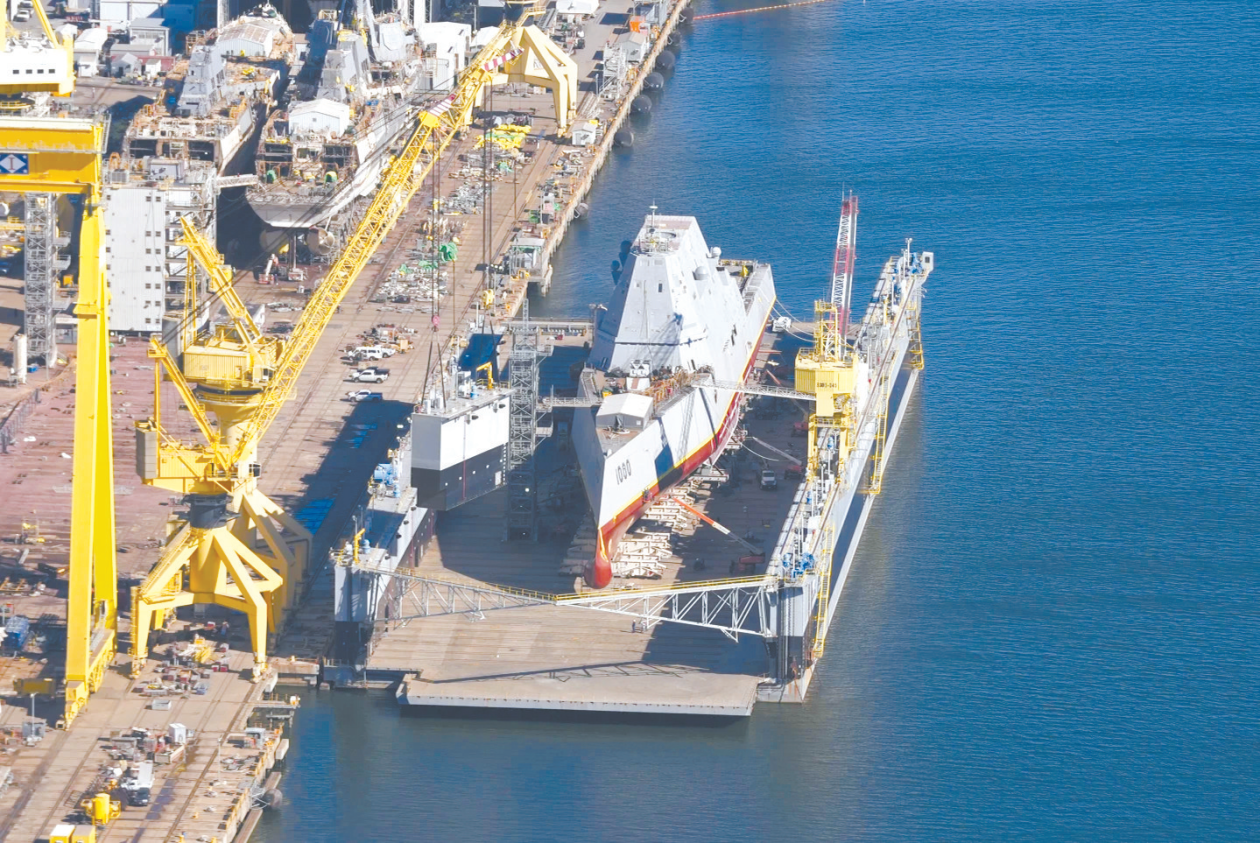The US Defense News reported on the 3rd that the US Navy is converting the stealth destroyer jumwalter into a carrier-based hypersonic missile launch platform, turn this much-maligned“Expensive mistake” into a powerful surface warfare weapon. U. S. experts say it is an important step for the U. S. to catch up with China and Russia in the hypersonic weapons field, but its future fate still faces many uncertain challenges.

The guided missile destroyer of the Zumwalt being refitted. (AP photo)
Turn waste into treasure
The guided missile destroyer is currently docked at the Huntington Ingles Industrial Shipyard in Mississippi, where workers removed two invisible gun turrets from the bow, the report said, a vertical launch system capable of launching hypersonic missiles. “Once the system has been modified, Zumwalt will be able to deliver rapid and accurate strikes from greater distances, increasing the ship’s utility.”.
Bryan Cluck, a defence analyst at the Hudson Institute, said the Zumwalt guided missile destroyer, the best on paper, was “An expensive mistake”. In the early 2000s, the US Navy, which thought it had no competition, used the 15,000-ton stealth destroyer as the main platform for its sea-to-land strategy, at its heart are two“Advanced artillery systems” that can be hidden in invisible turrets and provide ground-attack capability by firing a dedicated 155mm rocket-propelled projectile, open the way for Marines to land on the coast of a potential adversary. However, the US Navy misjudged the future development trend. With the rapid development of the navies of China, Russia and other countries, the focus of the US Navy fell back to the struggle for control of the ocean, the Zumwalt class guided missile destroyer was built only three times before it was finished. “Advanced artillery systems” not only no use, and because there is not enough equipment to share the cost of research and development, so that the cost of each rocket-propelled artillery shells up to 800,000 or even a million dollars, the result was that the“Advanced artillery system”“Never really started”.
But for the navy, the three Zumwalt class destroyers are still state-of-the-art surface warships with a wide range of innovative technologies, all-electric propulsion, highly stealthy design, unconventional wave-piercing hull, automatic fire and damage control, and integrated mast with hidden radar and other sensors are used. Cluck said the “US Navy can look to the failure of such advanced destroyers for victory and gain utility by turning them into hypersonic platforms”.
“High hopes.”
The US has developed various types of hypersonic weapons over the past 20 years, but rapid advances by Russia and China have put pressure on the US military, the report said. Hypersonic weapons fly at speeds in excess of Mach 5 and can be rerouted in flight to make them harder to shoot down.
According to the U. S. Navy vision, “Jumwalt” class destroyer equipped with hypersonic weapons is the“Conventional rapid strike” missile, by the U. S. Navy and army joint development. It is essentially a hypersonic boost glider missile, which uses a booster rocket to accelerate the hypersonic glider warhead to a sufficiently high speed and altitude, the unpowered warhead will detach from the booster and glide through the relatively low atmosphere, remaining fully maneuverable throughout and able to change course as needed to avoid interception. “Conventional rapid strike can fly at Mach 7 to Mach 8 until it hits its target,” said Zumwalt, whose destroyers will be equipped with four large-diameter missile tubes, each launch tube contains three hypersonic missiles, meaning each destroyer can carry up to 12 hypersonic missiles. The US Navy envisions a future in which“The US Navy will be able to strike anywhere on the planet in less than an hour” as destroyers equipped with the hypersonic missiles are deployed around the globe.
The Jumvoort began 2023 in August at the Huntington Ingles Industrial Shipyard. The ship will be docked this week in preparation for the next test and return to the fleet, said Kimberley Aguilard, a spokesman for the shipyard. The Navy hopes to begin testing the JUMWALTER’s hypersonic weapon systems on 2027 or 2028.
There is much controversy
But there has also been criticism in the United States over the costly refit of the Jumwalt. In particular, the development of the“Conventional rapid strike” missile has not gone well, with many delays in service, and in the eyes of critics, its actual combat results are not ideal. “This particular missile would cost as much as a dozen battle tanks, and would result in a precise non-nuclear explosion at great distances,” said Loren Thompson, an American military analyst. Is It really worth it? The answer is that, in most cases, the cost of a missile far exceeds anything you can destroy with it.
But retired Rear Admiral Ray Spicer said the hypersonic missiles gave the navy the ability to strike enemies from thousands of kilometres away with no effective defence. More important, he says, is that “The other side has them and we never want to be outdone,” says James E. Webb, chief technology officer for hypersonic technology in the office of the Assistant Secretary of Defence, hypersonic technology is considered critical to U. S. national security and has“High survivability and lethality.”. “The deployment of new capabilities based on hypersonic technology is a top priority for the Department of Defense to maintain and strengthen our integrated deterrent and build enduring advantage,” he stressed